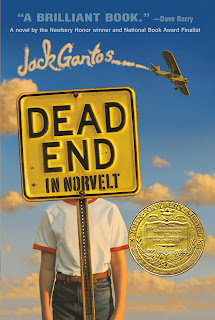"I search the sky for rainbows. I don't see any. But I know it doesn't mean they're not there." - pp. 217
Ninth Ward by Jewell Parker Rhodes
Published by Little, Brown and Company Copyright 2010
Strong female protagonist, coming of age, contemporary, rich in sensory details, inspiring
Awards:
- Best Fiction of 2010 - School Library Journal
- 2010 Parent's Choice Foundation Gold Award
- 2011 Coretta Scott King Award
- One of 2011's Notable Books for a Global Society
- Jane Addams Children's Book Honor Award for Older Readers
Summary:
Twelve year old Laneesha had lived her whole life in New Orleans' Ninth Ward District, one of the poorest places in the city. But Laneesha doesn't need anything more, she has her books, hopes to become an engineer one day, and of course, Mama Ya-ya, her adoptive grandmother. Laneesha is happy in her close community, until one day Mama Ya-ya has a vision of a hurricane coming: Katrina. As Laneesha balances between the life of the living and the ghosts that she sees, a struggle to survive ensues. This story is a powerful one, but also inspirational, showing that the love of family goes much further than just between blood relatives.
Reading Level: Lexile Framework 470L, Grade 3.3
Suggested Delivery: small group read, whole class instruction
Description: Current events, Diversity
Key Vocabulary (by page number): taunting (36), puncture (49), shroud (51), conflicted (111), indigents (118), bittersweet (145), siphoning (148)
Teaching Suggestions:
- Ninth Ward is written in a southern dialect. Be sure to talk with students about the difference between dialect and "school English". Explain that dialect is okay sometimes, and how it enhances the novel.
- Laneesha loves vocabulary words, providing readers with definitions of her favorites throughout the novel. When reading the book, have students find vocabulary words that they think are "good words." The words can be drawn from a hat every day as the word of the day.
- In the back of the novel, author Jewell Parker Rhodes provides a good background on Katrina for students. Read this author's note aloud and answer any questions that students may have.
Comprehension Strategies
Ninth Ward is a great novel to teach students about Hurricane Katrina, especially if they learn as they read instead of before or after reading. This way, they have an example to go off of in the novel for comprehension.
| taken from scholastic.com |
Pre-Reading- Before reading, post a KWL chart on the board, and have a group discussion on what students know (or think they know) about Katrina. Be prepared for students who have heard about issues with aid going to help victims, or about the socioeconomic divisions that came up during the disaster, and make sure to address these issues before completing the novel. There are several resources for students to look at to further understand the Hurricane, such as Scholastic News Online (below) and a special Time for Kids Katrina Special Report.
During Reading- While Laneesha does not have any blood relatives in her life, she is surrounded by "family" in Mama Ya-ya, her neighborhood, and when she and TaShon are rescued, even New Orleans as a whole who cheers for their survival. Ask students what family means to them. Have groups look at various scenes in the novel that show that family means more than blood and present their findings to the class. The passages below are good examples:
- Laneesha talks about how important her Ninth Ward family is to her - pp. 45-6.
- Mrs. Watson offers to take Laneesha and Mama Ya-ya with her when her family evacuates - pp. 91-2.
- The "good Cajun men" help bring TaShon and Laneesha to safety - pp. 216-7.
Post-Reading- Laneesha finds it important to learn as much as she can, whether it be from Mama Ya-ya or from school. Ask students how Laneesha's knowledge saved her from the Hurricane (her ability to work out the rate of water rising up the steps, her understanding of math to release the boat). Then, ask students what they like to learn about, impressing that knowledge is power.
Writing Activity: One of the themes of the novel is "fortitude," a word that Laneesha and TaShon learned at school before the hurricane and applied in their struggle to survive. How do the different characters in Ninth Ward demonstrate fortitude? Have students pick a character (any character will work!) and write a paragraph on what fortitude is, and how the character demonstrated it in the novel. Talk about Laneesha's actions to model the activity.
Electronic Resources:
Throughout the novel, many of the people of the Ninth Ward talk about how they don't want to leave because they think they will be safe, because they cannot afford it, or choose to have a party instead of preparing for the hurricane. The American Red Cross provides a great activity to help students grades 3-5 understand that preparedness is always the best option. Using the prompts from the "Wrap up" section on page three of the Response and Recovery unit, talk about where in the book that characters presented these beliefs, and how characters could have reacted differently. The prompts are as follows:
- “I’ve lived here all my life and I’ve weathered hurricanes before. I can do it again."
- "I can't stand the traffic jam that an evacuation order will create."
- I can't afford to evacuate."
- "I'm afraid to leave my home unprotected. Someone might loot it."
Rhodes, J. P. (2010). Ninth Ward. New York: Little, Brown and Co..



